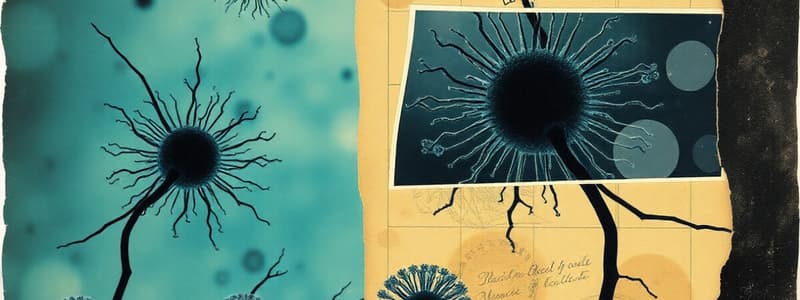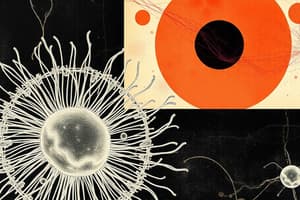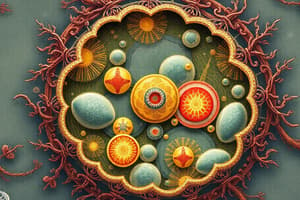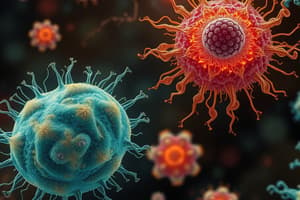Podcast
Questions and Answers
What is the primary difference between eukaryotic flagella and bacterial flagella?
What is the primary difference between eukaryotic flagella and bacterial flagella?
- Eukaryotic flagella are covered by an extension of the cell membrane, while bacterial flagella are not (correct)
- Eukaryotic flagella are typically shorter than bacterial flagella
- Bacterial flagella are about ten times thicker than eukaryotic flagella
- Eukaryotic flagella are structurally simpler than bacterial flagella
In what way are eukaryotic cilia similar to eukaryotic flagella?
In what way are eukaryotic cilia similar to eukaryotic flagella?
- They both are covered in a sheath that extends from the cell membrane
- They are both found only in a single group of protozoa
- They both are about ten times thicker than bacterial flagella
- They both possess a 9 + 2 arrangement of microtubules (correct)
How did complex multicellular organisms evolve from primitive eukaryotes?
How did complex multicellular organisms evolve from primitive eukaryotes?
- Multicellular organisms developed as a result of mutations that made single-celled organisms larger
- Primitive eukaryotes developed the ability to survive independently and form multicellular organisms
- Colonies of primitive eukaryotes formed, with cells specializing in specific functions (correct)
- Primitive eukaryotes gradually developed internal specialized structures over time
What is meant by the phrase '9 + 2 arrangement' in the context of eukaryotic flagella?
What is meant by the phrase '9 + 2 arrangement' in the context of eukaryotic flagella?
What type of structure is responsible for the movement of both cilia and flagella?
What type of structure is responsible for the movement of both cilia and flagella?
What is the primary function of the cell wall in fungi?
What is the primary function of the cell wall in fungi?
What is the function of the glycocalyx in a eukaryotic cell?
What is the function of the glycocalyx in a eukaryotic cell?
Which of the following is NOT a characteristic of the cell membrane in eukaryotic cells?
Which of the following is NOT a characteristic of the cell membrane in eukaryotic cells?
What is the function of the nucleolus?
What is the function of the nucleolus?
Which of the following correctly describes the role of the endoplasmic reticulum?
Which of the following correctly describes the role of the endoplasmic reticulum?
What is the main function of the Golgi apparatus?
What is the main function of the Golgi apparatus?
Which of the following is NOT a characteristic of mitochondria?
Which of the following is NOT a characteristic of mitochondria?
What is the primary function of chloroplasts?
What is the primary function of chloroplasts?
Which of the following statements describes the role of ribosomes in protein synthesis?
Which of the following statements describes the role of ribosomes in protein synthesis?
What is the function of the cytoskeleton?
What is the function of the cytoskeleton?
What are the two basic cell forms found in fungi?
What are the two basic cell forms found in fungi?
What is a primary reproductive mode of fungi?
What is a primary reproductive mode of fungi?
What is the difference between community-acquired infections and hospital-associated infections caused by fungi?
What is the difference between community-acquired infections and hospital-associated infections caused by fungi?
What is an opportunistic fungal infection?
What is an opportunistic fungal infection?
Which of the following is NOT a characteristic of filamentous fungi?
Which of the following is NOT a characteristic of filamentous fungi?
How do fungi contribute to agricultural impact?
How do fungi contribute to agricultural impact?
What is the function of vegetative hyphae in fungi?
What is the function of vegetative hyphae in fungi?
What is the main limiting factor for protozoan growth?
What is the main limiting factor for protozoan growth?
What is the primary way fungi acquire nutrients?
What is the primary way fungi acquire nutrients?
Why are fungi often found in nutritionally poor or adverse environments?
Why are fungi often found in nutritionally poor or adverse environments?
Which of the following protozoans does NOT form cysts?
Which of the following protozoans does NOT form cysts?
What is the purpose of conjugation in ciliates?
What is the purpose of conjugation in ciliates?
Which of the following organisms is NOT a helminth?
Which of the following organisms is NOT a helminth?
What is the name given to the host where a helminth larva develops?
What is the name given to the host where a helminth larva develops?
Which of the following helminths is hermaphroditic?
Which of the following helminths is hermaphroditic?
What is the name of the dormant, resting stage that some protozoans enter when conditions become unfavorable?
What is the name of the dormant, resting stage that some protozoans enter when conditions become unfavorable?
Which of the following is a common method of transmission for protozoan infections?
Which of the following is a common method of transmission for protozoan infections?
What is the name of the common intestinal worm that causes enterobiasis?
What is the name of the common intestinal worm that causes enterobiasis?
What is the primary method of reproduction for protozoans?
What is the primary method of reproduction for protozoans?
Which of the following is a characteristic of flatworms?
Which of the following is a characteristic of flatworms?
What is the most developed organ in pathogenic helminths?
What is the most developed organ in pathogenic helminths?
What is the name of the host where a helminth reaches adulthood and reproduces?
What is the name of the host where a helminth reaches adulthood and reproduces?
Flashcards
Eukaryotic Cells
Eukaryotic Cells
Cells with a defined nucleus and organelles, often multicellular.
Flagella
Flagella
Long, whip-like structures that aid in cell movement in eukaryotes.
Cilia
Cilia
Short, hair-like structures that help cells move or push substances.
9 + 2 Arrangement
9 + 2 Arrangement
Signup and view all the flashcards
Cell Specialization
Cell Specialization
Signup and view all the flashcards
Glycocalyx
Glycocalyx
Signup and view all the flashcards
Cell Wall
Cell Wall
Signup and view all the flashcards
Cell Membrane
Cell Membrane
Signup and view all the flashcards
Nucleus
Nucleus
Signup and view all the flashcards
Nucleolus
Nucleolus
Signup and view all the flashcards
Endoplasmic Reticulum (ER)
Endoplasmic Reticulum (ER)
Signup and view all the flashcards
Golgi Apparatus
Golgi Apparatus
Signup and view all the flashcards
Lysosomes
Lysosomes
Signup and view all the flashcards
Mitochondria
Mitochondria
Signup and view all the flashcards
Chloroplasts
Chloroplasts
Signup and view all the flashcards
Ribosomes
Ribosomes
Signup and view all the flashcards
Cytoskeleton
Cytoskeleton
Signup and view all the flashcards
Yeasts
Yeasts
Signup and view all the flashcards
Fungal Nutrition
Fungal Nutrition
Signup and view all the flashcards
Opportunistic Infections
Opportunistic Infections
Signup and view all the flashcards
Mycelium
Mycelium
Signup and view all the flashcards
Septa
Septa
Signup and view all the flashcards
Nonseptate hyphae
Nonseptate hyphae
Signup and view all the flashcards
Vegetative hyphae
Vegetative hyphae
Signup and view all the flashcards
Reproductive hyphae
Reproductive hyphae
Signup and view all the flashcards
Sporangiospores
Sporangiospores
Signup and view all the flashcards
Conidia
Conidia
Signup and view all the flashcards
Trophozoite
Trophozoite
Signup and view all the flashcards
Cyst
Cyst
Signup and view all the flashcards
Heterotrophic
Heterotrophic
Signup and view all the flashcards
Conjugation in ciliates
Conjugation in ciliates
Signup and view all the flashcards
Flatworms (Platyhelminthes)
Flatworms (Platyhelminthes)
Signup and view all the flashcards
Nematodes
Nematodes
Signup and view all the flashcards
Life cycle of helminths
Life cycle of helminths
Signup and view all the flashcards
Enterobius vermicularis
Enterobius vermicularis
Signup and view all the flashcards
Study Notes
Overview of Eukaryotic Cells
- First primitive eukaryotes were single-celled and independent
- Over time, cells aggregated to form colonies
- Cells within colonies specialized for specific functions
- Complex multicellular organisms evolved as individual cells lost the ability to survive independently
External Cell Structures
- Flagella: Similar to cilia but longer. About 10 times thicker than bacterial flagella, more complex in structure, have a membrane extension containing regularly spaced microtubules.
- Cilia: Similar to flagella in structure but smaller and more numerous, found in certain animal and protozoa cells.
Microtubules in Flagella
- Regularly spaced microtubules extend along the entire length of the flagellum
- Nine pairs of microtubules surround a single pair
- Arrangement is known as 9 + 2
The Glycocalyx
- An outermost layer that directly contacts the environment
- Composed of polysaccharides
- Appears as a network of fibers
Boundary Structures: Cell Walls
- Protozoa and helminths lack cell walls.
- Fungal cell walls are rigid, providing structure and shape.
- Different chemical composition from bacterial and archaeal cell walls
- Thick inner layer (chitin or cellulose) and a thin outer layer (mixed glycans)
Boundary Structures: Cell Membranes
- Composed of a phospholipid bilayer with embedded protein molecules
- Contains sterols that provide stability
- Important in cells without cell walls
- Has a similar function to bacteria and archaea membranes (selectively permeable barriers)
Internal Structures: The Nucleus
- Prominent eukaryotic organelle
- Separated from the cytoplasm by a nuclear envelope composed of 2 membranes
- Contains pores allowing macromolecule movement between cytoplasm and nucleus
- Nucleolus: site of ribosomal RNA synthesis
- Chromatin: made of linear DNA and histone proteins
Internal Structures: Endoplasmic Reticulum
- Network of membrane tunnels involved in transport and storage
- Rough ER has ribosomes attached for protein synthesis
- Smooth ER involved in lipid synthesis and nutrient processing
Internal Structures: Golgi Apparatus
- Involved in protein modification and directing proteins to their destinations
- Consists of flattened sacs (cisternae)
- Closely associated with ER
- Modifies and packages proteins using carbohydrates and lipids
Vesicles
- Lysosomes: Contain enzymes for intracellular digestion
- Bud off from the Golgi apparatus
Mitochondria
- Generate energy for the cell
- Have an outer and inner membrane with cristae forming folds
- Contain enzymes and electron carriers for aerobic respiration
- Contain circular DNA/ 70S ribosomes; hypothesized to evolve from bacteria cells
Chloroplasts
- Found in algae and plants
- Convert sunlight into chemical energy via photosynthesis
- Contain a unique set of pigments
Ribosomes
- Scattered in cytoplasm or attached to Rough ER
- Found inside mitochondria and chloroplasts
- Large and small subunits of ribonucleoprotein
- Involved in protein synthesis
The Cytoskeleton
- Three types of elements: Actin filaments, Intermediate filaments, Microtubules
- Provide support, movement, and anchoring for organelles.
Fungal Cells
- Two main forms: Yeasts (round to oval) and Hyphae (long threadlike)
- Yeast cells reproduce by budding
- Fungi in nature are either heterotrophic (absorb from organic matter) or saprobes/parasites (absorbing from dead organisms or living organisms)
- Cell walls made of chitin or cellulose
Fungi and Human Disease
- Approximately 300 fungal species can cause human disease.
- Common types include community-acquired, hospital-associated, and opportunistic infections.
Protozoa
- Single-celled eukaryotic organisms, found in water and soil environments.
- Most are harmless, some are pathogens
- Some have specialized structures (oral grooves) for feeding.
- Reproduce asexually or sexually, some have life cycles with both trophozoite (feeding) and cyst phases (dormant).
- Important cause of disease and can be transmitted in water and food.
Helminths
- Multicellular animals that reproduce sexually
- Include tapeworms, flukes, and roundworms
- Some are harmless, others lead to disease
- Often have complex life cycles requiring multiple hosts
Studying That Suits You
Use AI to generate personalized quizzes and flashcards to suit your learning preferences.




